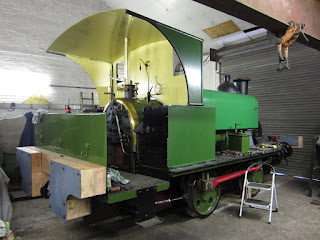
No.18 – some curatorial observations
Below: A close up of the cab now that most of the fittings are in place. The pressure gauge has been removed to enable painting to be carried out. The new regulator handle has been made, note how it sweeps forwards to avoid the Salter spring balance. The brass safety valve tube (to direct steam out of the cab from the safety valve itself), so ably made by David Young, is in place and the various valves are temporarily in place. The interior finish will be wood grained, with black borders and yellow pinstriping borders – which should look very nice and very North Eastern! The oil pots for the rear axleboxes are also to fit to the cabsheet and these have been overhauled and fitted to brackets made by Dave.
Below: When a new boiler barrel was fitted in the 1990s, the original contractor set the clack valve pads on the boiler centre-line. In fact they should sit below this, and as a result the tank has had to be set higher than it would have been originally. As a result of the chaning datum, and desire to minimise hole drilling in original material, the tank support brackets have had to be swept inwards to adequately support the tank. This is quite a significant change in appearance, though will be partially hidden by sandboxes, injectors and pipework. Note the oil box to the rear of the front bracket – this feeds the front axlebox on this side of the engine. However, this compromise ensures that numerous other features, and the original footplating sections (and frames of course) are kept intact.
Hopefully the above notes are a useful insight into the process required to conserve the existing material and integrate the new, all to a standard to enable the locomotive to operate, hopefully for very many years to come. It is probable that most observers would not notice, but as a museum we should aspire to the highest standards, and the engine, allied to the comprehensive drawings (which will be available to modellers and historians) and CMP will give the fullest story of No.18 and its 134 year history. Other items contained within the CMP include lists of new components (so future students can identify what is original and what is not), patterns and a restoration diary.







Recent Comments